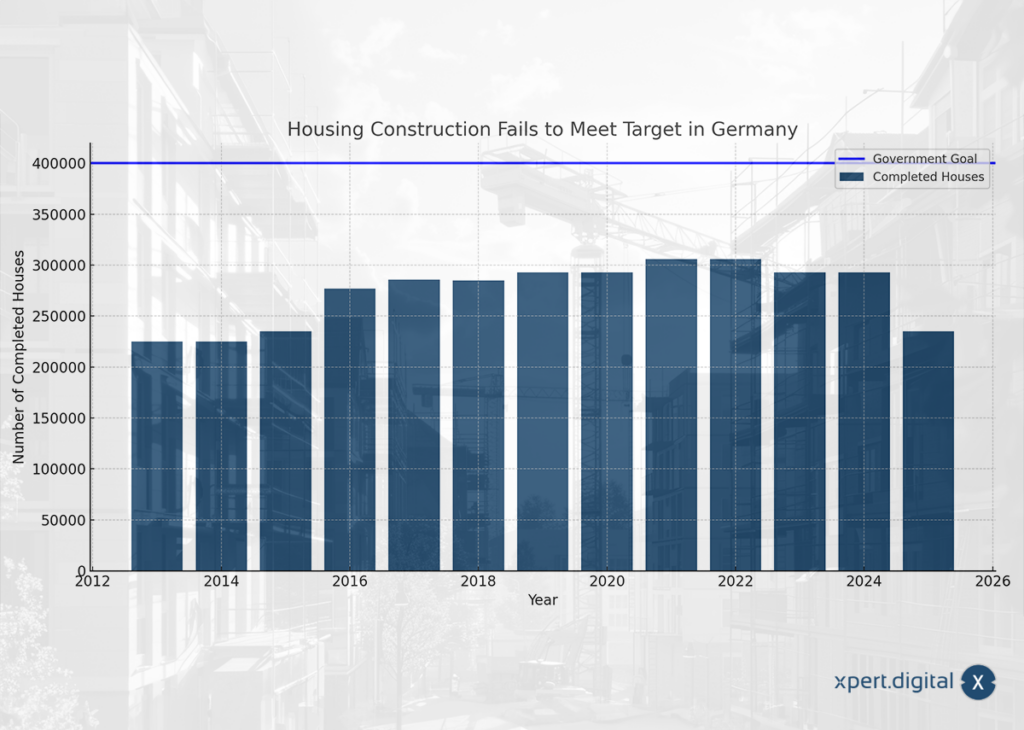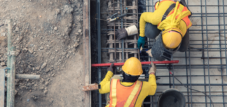Housing crisis 2024: Housing in crisis - How is housing construction developing in Germany?
Language selection 📢
Published on: August 2, 2024 / update from: August 2, 2024 - Author: Konrad Wolfenstein

The challenge of housing construction: causes and solutions for missing targets – Image: Xpert.Digital
🏠🔻 The decline in housing construction in Germany: causes and perspectives
📉🏢 The continuous downward spiral in German housing construction continues unabated. According to a forecast by the Ifo Institute, the number of completed apartments could fall to just 175,000 by 2026. A significant decline considering that around 300,000 homes were still built in 2022. At the same time, there has also been a decline in the number of building permits issued. In addition, the new property tax from next year will cause problems for many property owners, while municipal revenues are continually increasing. But there is also positive news: housing affordability has increased significantly and is above the level of the 1980s.
📉 Forecasts and reality
The Munich ifo Institute predicts a sustained decline in housing construction in Germany in the coming years. The expected 175,000 new apartments in 2026 represent a decline of over 40 percent compared to the almost 300,000 apartments in 2022. Ludwig Dorffmeister, an expert at the ifo Institute, emphasized to the German Press Agency: “The forecast is There are uncertainties, but it is pretty clear that we will slip below the 200,000 mark by 2026 at the latest." This means that the Berlin coalition's ambitious goal of building 400,000 new apartments annually is becoming increasingly distant.

Number of completed apartments in Germany – housing construction misses the target – Image: Xpert.Digital
📊 Factors influencing housing construction
Several factors contribute to this negative trend. Material prices have increased significantly in recent years. These price increases affect not only wood, steel and other building materials, but also transport and logistics costs. Added to this are the increased building interest rates, which have tripled and thus significantly increase the financing costs for construction projects. This financial burden makes it difficult for private developers and investors alike to realize new projects.
The construction crisis does not only affect single-family homes and rental apartments. Commercial real estate and important infrastructure projects such as roads and sewage systems in cities and towns are also affected by rising costs and falling construction activity.
🏢🏬 Consequences for the housing market
This declining trend in housing construction has far-reaching consequences for the housing market. In the short term, this could lead to a further shortage of living space, particularly in metropolitan areas and large cities. This could further increase rental prices and worsen the housing situation for many people. In the long term, however, an insufficient supply of new apartments could also stabilize or even increase the price of existing properties.
💰🏚 Housing affordability
Amid these negative developments, there is also a ray of hope: the affordability of residential property has increased again and is well above the level of the 1980s. This can be attributed primarily to the overall increase in income and the historically low interest rates in recent years, which have made it easier to purchase home ownership despite rising prices.
🏛️ Policy measures and challenges
Comprehensive political measures are necessary to counteract the crisis in housing construction. The federal government has already launched various initiatives to promote housing construction and accelerate the creation of new living space. These include, among other things, tax incentives, support programs for social housing and a reduction in bureaucracy in building regulations.
Despite these efforts, it is clear that the measures taken so far are not enough to reverse the negative trend. Further efforts and more intensive cooperation between the federal, state and local governments are required to overcome the obstacles in housing construction and achieve the desired goals.
🔮🏗️ Future prospects
The German housing market is facing major challenges. The ongoing shortage of materials, rising building interest rates and the associated higher costs for new buildings require innovative solutions. Increased promotion of more sustainable and cost-effective construction methods, such as modular construction or the use of recycled materials, could contribute to easing the housing market.
🚨🏠 The situation in German housing construction is alarming
The combination of rising material costs, increased building interest rates and declining construction activity presents the market with significant challenges. The forecast figures from the Ifo Institute paint a bleak picture: by 2026, the number of completed apartments could fall to 175,000.
Political and economic actors must work together on solutions to counteract this development. At the same time, the rise in housing affordability shows that there are positives to build on. Only through a coordinated approach can we succeed in boosting housing construction in Germany and meeting the needs of the population.
📣 Similar topics
- 🏠 The downward spiral in German housing construction
- 📉 Ifo Institute forecast: A gloomy outlook
- 🛠️ Influencing factors: What hinders construction
- 💸 Building interest and material prices: The cost explosion
- 🏘️ Consequences for the housing market
- 📈 Housing Affordability: A Bright Spot
- 🏛️ Political measures against the construction crisis
- ⚖️ Challenges in implementing the reforms
- 🌍 Future prospects: Sustainable construction methods as a solution?
- 🏗️ Germany is building – but not enough
#️⃣ Hashtags: #Housing construction #Forecasts #Material costs #Political measures #Housing market
🏗️🔥☀️📉 Construction, heat pump and photovoltaic market slump - The political image damage - An overall analysis of the causes

Construction industry, heat pump and photovoltaic market slump - The political damage to the image - A partial analysis of the causes - Image: Xpert.Digital
Another issue affecting the market is the shortage of skilled workers. qualified in both the installation and maintenance of heat pumps and photovoltaic systems – master electricians in particular are desperately needed. An intensified training offensive and investments in further training could remedy this and provide the necessary workforce.
Political uncertainties, a lack of expertise, insufficient funding and technological deficits are the main reasons for the collapse in these crucial markets. The ecological and economic damage that Germany is suffering as a result is considerable and could have long-term consequences.
More about it here:
📉🏠 Low point in housing construction permits: Germany is fighting against increasing housing shortages
📉🏡 Drastic slump: Housing construction permits in Germany at record low
In 2023, Germany already recorded a low in housing construction permits, but the situation has worsened further this year. According to the Federal Statistical Office, only 71,591 building permits were issued for apartments in newly built residential buildings between January and May of this year. This corresponds to a decrease of 24 percent compared to the same period last year and even a decrease of 42 percent compared to 2020.
This development suggests that the housing shortage in Germany will continue to worsen. The number of completed apartments is already well below the target of 400,000 per year set by the federal government. This situation is particularly problematic for people with low incomes and tenants in large cities, as they are particularly hard hit by rising rents.
According to Destatis, on average in Germany 27.8 percent of income has to be spent on rent. In cities with a population of more than 100,000 people, this proportion is as high as 28.9 percent. For households with a monthly net household income of 1,500 euros or less, the burden increases dramatically and can require over 40 percent of income.

Low point in housing building permits: Germany is fighting against increasing housing shortages - Image: Xpert.Digital
📉 Causes and consequences of the situation
The drastic decline in building permits has several reasons. On the one hand, increased construction costs play a significant role. Raw materials such as wood, steel and concrete have become more expensive, which is putting a considerable strain on the construction industry. Added to this are delivery bottlenecks and increased energy costs, which are further driving up construction costs.
In addition, many property developers and investors are faced with the problem of rising interest rates. This makes financing new construction projects more expensive, so that many projects are either postponed or canceled entirely. The European Central Bank's interest rate change also has a direct impact on housing construction.
In addition, there are bureaucratic hurdles that delay or even prevent the construction of new apartments. Approval procedures are often lengthy and complicated, which causes many construction projects to stall. The introduction of digital approval procedures could help here, but implementation is still a long time coming in many places.
🏠 Impact on society
The shortage of living space has far-reaching consequences for society. As already mentioned, low-income households are particularly affected. They are getting into financial difficulties due to rising rents and have to spend an ever larger portion of their income on housing. This leads to increasing social inequality and widens the gap between rich and poor.
The situation is particularly explosive in large cities. Here, living space is particularly scarce and expensive. Many people are forced to move to smaller apartments or poorer neighborhoods. This can have an impact on social structures and lead to the formation of social hotspots.
Families are also affected by the housing shortage. Many cannot find suitable apartments with enough space for children. This can mean that families have to limit their choice of place of residence or have to give up the dream of owning their own home.
🏛️ Politics and solutions
The federal government has recognized the problem and has discussed various measures to stimulate housing construction again. A central point is the promotion of social housing. Financial incentives should be created here to build more affordable housing. Promoting the purchase of home ownership for families through low-interest loans or grants is also among the measures being discussed.
Another starting point is the de-bureaucratization of construction processes. The construction of new apartments is intended to be made easier through simplified and accelerated approval procedures. This also includes expanding digital processes to shorten processing times.
An innovative approach is densification in existing residential areas. Unused areas in existing settlements are used to create new living space. This could be done, for example, by building attic apartments or converting empty office buildings.
Furthermore, cooperation between the federal, state and local authorities is seen as an important factor. The housing problem can only be effectively addressed through coordinated measures at all political levels.
🔮 Looking into the future
While the current figures and forecasts for the housing situation in Germany are alarming, there are still opportunities for improvement. Housing construction could be revolutionized through innovative technologies and sustainable construction methods. An example of this is 3D printing of buildings, which creates living space more quickly and cost-effectively.
The topic of sustainable building is also becoming more and more important. Energy-efficient and climate-friendly construction methods are not only good for the environment, but can also save costs in the long term. Funding programs and legal requirements could help promote sustainable construction projects.
The current challenges in housing construction in Germany are complex and require a variety of measures. A combination of short-term and long-term strategies, political determination and innovative approaches could help improve housing and address housing shortages. The coming period will show to what extent the planned measures can be implemented and what effect they will have on the market. Only through joint action and innovative solutions can the goal of creating enough affordable living space for all segments of the population be achieved.
🛠️ Construction industry, construction industry, construction sector: compensate for labor shortages and housing shortages with automation and robotics
AI & XR 3D Rendering Machine – symbolic image: construction industry
The construction industry faces numerous challenges affecting both cost structure and access to labor and housing. Rising labor costs are a direct result of the skills shortage, which is exacerbated by an aging population, lower entry rates into skilled trades and migration trends. The lack of available and affordable housing further exacerbates these problems as it has become a key social issue for both workers and end customers.
More about it here:
We are there for you - advice - planning - implementation - project management
☑️ Industry expert, here with his own Xpert.Digital industry hub with over 2,500 specialist articles
I would be happy to serve as your personal advisor.
You can contact me by filling out the contact form below or simply call me on +49 89 89 674 804 (Munich) .
I'm looking forward to our joint project.
Xpert.Digital - Konrad Wolfenstein
Xpert.Digital is a hub for industry with a focus on digitalization, mechanical engineering, logistics/intralogistics and photovoltaics.
With our 360° business development solution, we support well-known companies from new business to after sales.
Market intelligence, smarketing, marketing automation, content development, PR, mail campaigns, personalized social media and lead nurturing are part of our digital tools.
You can find out more at: www.xpert.digital - www.xpert.solar - www.xpert.plus

























